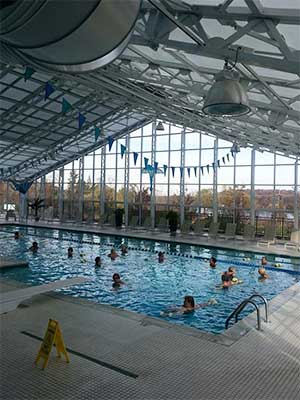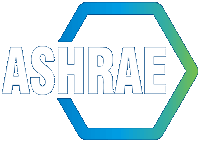- Why is a dehumidification system necessary to control humidity in an indoor pool/natatorium?
- How can I tell if the moisture level is excessive?
- How do you size the system?
- What are the recommended humidity levels for an indoor pool/natatorium?
- What are the recommended temperatures for a natatorium?
- Why can’t we use outside air and exhaust fans in a natatorium?
- What is included in the price?
Why is a dehumidification system necessary to control humidity in an indoor pool/natatorium?
 Indoor pools and spas, due to the nature of containing a large body of water, have a much higher humidity level than any other area of commercial or residential buildings. As this moisture reaches a 100% humidity saturation level within the pool room, humidity and moisture—if not controlled—are destructive to dry wall, wood, metal, insulation, interior structural members, and equipment. Additionally, this can foster an uncomfortable and unhealthy environment for all.
Indoor pools and spas, due to the nature of containing a large body of water, have a much higher humidity level than any other area of commercial or residential buildings. As this moisture reaches a 100% humidity saturation level within the pool room, humidity and moisture—if not controlled—are destructive to dry wall, wood, metal, insulation, interior structural members, and equipment. Additionally, this can foster an uncomfortable and unhealthy environment for all.
A properly designed indoor pool dehumidification system will prevent the early deterioration of the structure by reducing the pool room humidity levels to the standards required by ASHRAE. While dehumidifying the indoor pool room environment, the system will also provide the necessary heating, cooling and additional free heat resources to the natatorium.
How can I tell if the moisture level is excessive?
The signs include an uncomfortable space, the presence of mold, corrosion, rust, wet and/or saturated drywall, ceilings caving in, and windows dripping to name a few.
How do you size the system?
 There are many variables to be considered when designing the appropriate system for a natatorium. Aquametry/DXair is not a licensed mechanical engineering firm, not an architectural firm, nor a licensed mechanical installation firm, therefore we cannot and do not take responsibility for the sensible calculations/building loads for natatoriums. This is the responsibility of the end user, client, representative, and/or mechanical firm to obtain this information.
There are many variables to be considered when designing the appropriate system for a natatorium. Aquametry/DXair is not a licensed mechanical engineering firm, not an architectural firm, nor a licensed mechanical installation firm, therefore we cannot and do not take responsibility for the sensible calculations/building loads for natatoriums. This is the responsibility of the end user, client, representative, and/or mechanical firm to obtain this information.
Building loads and sensible calculations must be provided by your engineering/mechanical or architectural firm. If not provided (i.e. retrofit structures, older buildings or information no longer available), new loads may be necessary and required to finalize the quotation and sizing of systems. If not provided, the Aquametry quotation/sizing of systems is estimated only.
Aquametry “engineering” provides for calculations based on the total square feet of the natatorium space to be conditioned, the dimensions of the pool/spa, other water features installed, ceiling height of the space, design temperatures of water and air for evaporation rates (or your engineer’s mechanical schedule), how the structure is built, insulation factors, how the pool is used, pool chemistry used, evaporation rates based on design temperatures, heating method, if cooling is required and the method of cooling to be used.
DXair works with each client to understand their unique requirements, and them recommend the most efficient, cost effective system based on these requirements and the sensible calculations/loads provided by your engineering firm.
What are the recommended humidity levels for an indoor pool/natatorium?
ASHRAE 2019 HVAC Applications Manuals, Chapter 6 (American Society of Heating, Refrigerating and Air-Conditioning Engineers) recommends 50-60% relative humidity to maintain the integrity of the structure and comfort of patrons.
What are the recommended temperatures for a natatorium?
ASHRAE 2019 HVAC Applications Manuals provide a range of temperatures depending upon commercial and residential and design requirements. Certain projects maintain warmer water such as physical therapy/rehabilitation centers, diving schools, retirement facilities, etc.
DXair will discuss the specifics of your project with you to help determine the best settings for your needs. With hotels, 80-84 degree water and the air temperature set 2° warmer than the water (without a pool cover) is a general “rule of thumb” (i.e. 82° water/84° air, and cooling set at 86° or higher).
Why can’t we use outside air and exhaust fans in a natatorium?
 An exhaust fan system or “Waste Ventilation System” (see Waste Ventilation Design Guideline for additional information), as this is generally called, cannot control humidity in an indoor pool or natatorium 365 days per year. This system brings in outside air and “exchanges” it with inside pool room air by using exhaust fans to pull the moisture laden air out of the pool room. This “mother nature” approach might work on days when the outdoor air is the same temperature as the pool room and the humidity levels are as low as the pool room but these conditions rarely exist. A heat source is generally added to the heat the room.
An exhaust fan system or “Waste Ventilation System” (see Waste Ventilation Design Guideline for additional information), as this is generally called, cannot control humidity in an indoor pool or natatorium 365 days per year. This system brings in outside air and “exchanges” it with inside pool room air by using exhaust fans to pull the moisture laden air out of the pool room. This “mother nature” approach might work on days when the outdoor air is the same temperature as the pool room and the humidity levels are as low as the pool room but these conditions rarely exist. A heat source is generally added to the heat the room.
This type of system may appear to be the least expensive; however, because it is ineffective at controlling humidity. The cost of repairing the damages from excessive humidity, and the energy and utility costs, can make it a very expensive option. Today’s systems control humidity, reclaim all of the “free” heat in the room, and put this free heat back into your room and pool. This is truly much more energy efficient than waste ventilation systems and there are no humidity problems—all 365 days per year!
The answer is also clearly demonstrated in the appalling image of a “health club” of all places. By relying on an exhaust fan/waste ventilation system instead of proper dehumidification, you can see both the structural deterioration and mold and mildew accumulation in this pool room which forced it to be shut down. This of course was caused by excessive humidity.
What is included in the price?
A complete packaged heat recovery pool dehumidification system is included in our pricing. As a manufacturer our “engineering” includes includes our dehumidifier sized according to the building loads (sensible calculations/heat loss and heat gain in BTU’s) you provide, the heating of the space based upon your choice of electric, gas, propane, hot water coil or geothermal, assistance with sizing, design and layout of your duct work/air delivery system for our system. We will size each system based on all loads provided, the air turnover rate required, supply air and return air CFM.
We will also design for heat recovery/pool heat reclaim if this option can be used. We will provide guidelines for building materials, mechanical space, insulation, windows, lighting, vapor barriers, outside air, and negative pressure. We will provide information regarding the materials used for your air delivery system. We recommend each customer research all of the resources available to them in the design stages for the building, design stages for the dehumidification system and utilizing ASHRAE HVAC Applications Manuals, ASHRAE Manuals for all building requirements, ACCA Manauls, SPS Manuals and the dehumidification manufacturer’s recommendations.
Aquametry/DXair is not a licensed mechanical engineering firm, not an architectural firm and is not licensed for mechanical installations. Therefore, Aquametry does not provide nor calculate any building loads (heat loss/heat gain/sensible calculations) for the space. This is the responsibility of the customer/end user, mechanical engineering firm, builder, or architectural firm. All proposals will be considered estimates only without the engineering calculations and the pool room data required.
This web site information, content, and guidelines are subject to change.
Please email us if you would like to see a specific question and answer included in our FAQ’s. Check back often as DXair updates these FAQ’s!
Check out the Design Guideline Bulletins for more information…
